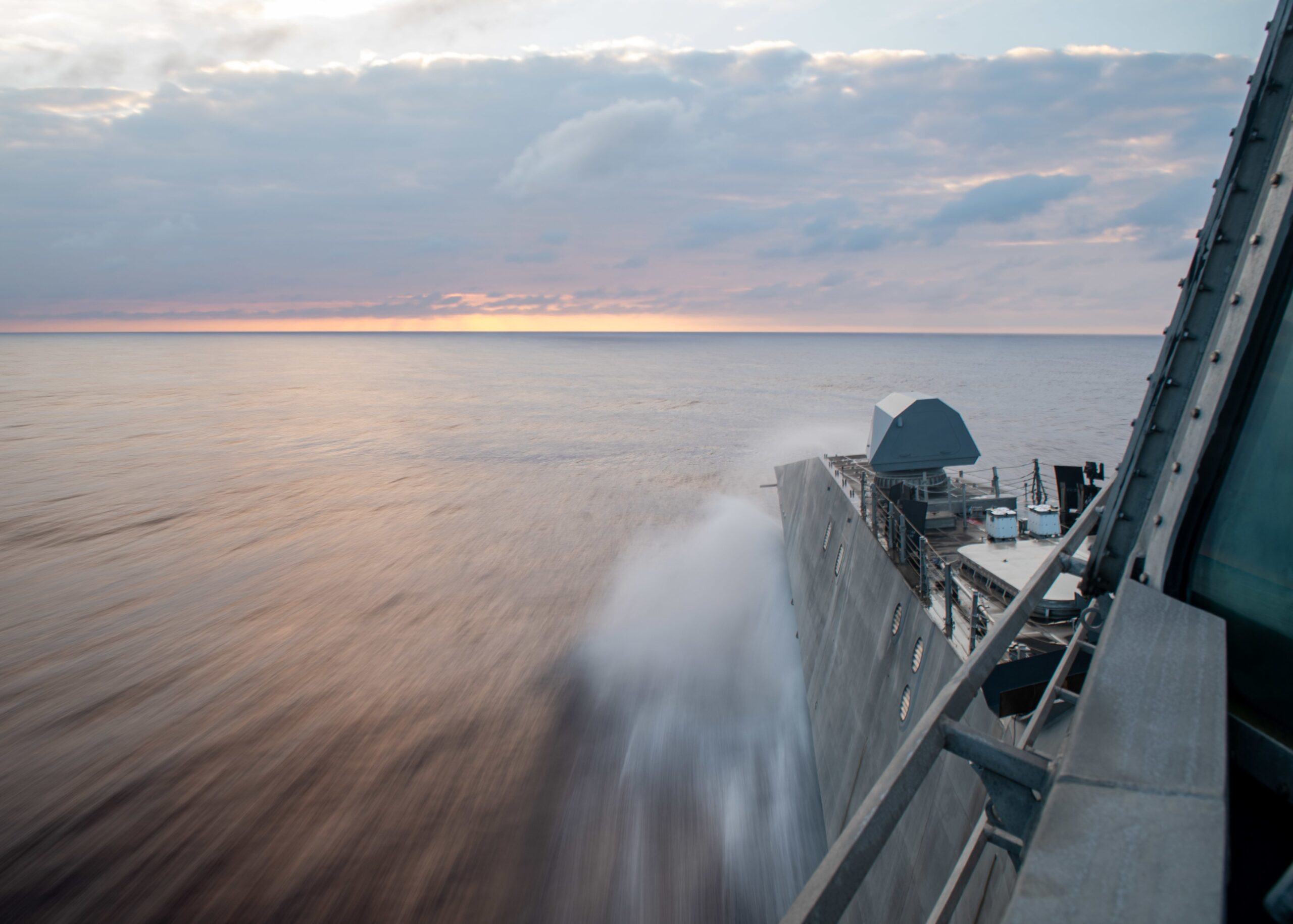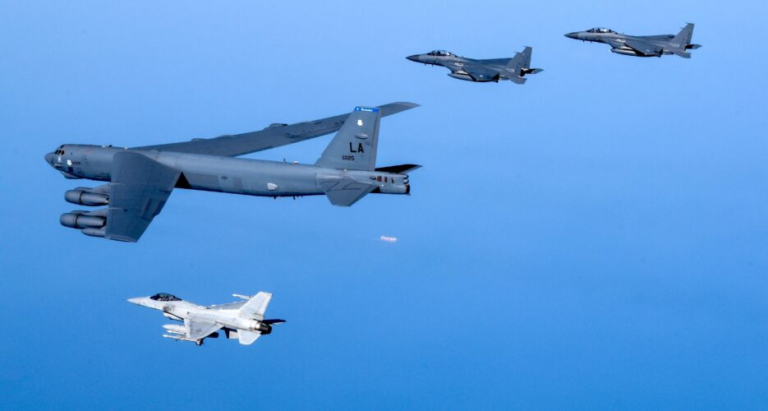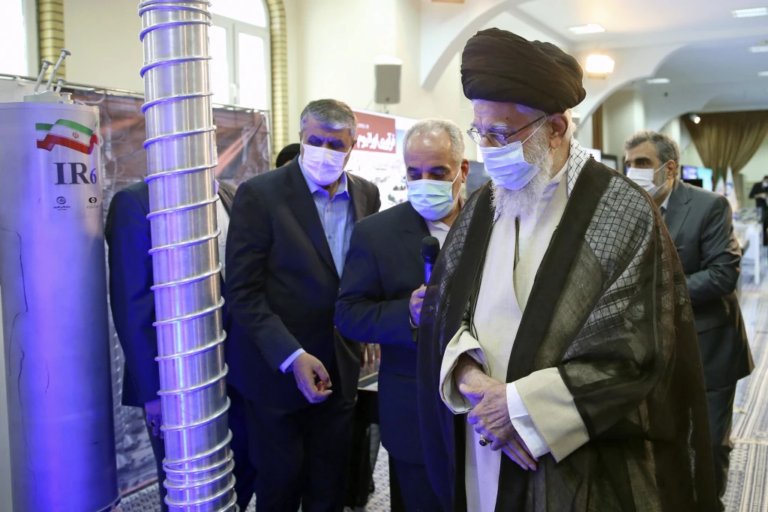As maiden deployments go, the one USS Charleston (LCS-18) just wrapped is one for the record books.
The Independence-class Littoral Combat Ship returned to its San Diego, Calif., homeport last week, closing out a 26-month rotational deployment overseas. During that time, the ship operated across the U.S. 7th Fleet and 3rd Fleet regions with five rotations of its two crews, with the gold crew completing three rotations and the alternative with the blue crew, which did two.
Cmdr. Matthew Knuth, who as the gold crew commanding officer brought the ship home on June 14, lauded the crews and families’ “dedication and their perseverance.”
Knuth and his gold crew drove Charleston on the final leg to Naval Base San Diego, marking the longest deployment so far of any littoral combat ship. That’s by intent. The deployment’s length “was based on fleet commander tasking and the scheduled necessity for us out there,” Knuth said Wednesday during a media call.
Charleston, which the Navy commissioned in 2019, left its berth at Naval Base San Diego on April 7, 2021, with an embarked MH-60S Knighthawk detachment with Helicopter Sea Combat Squadron 21 from Naval Air Station North Island, Calif.
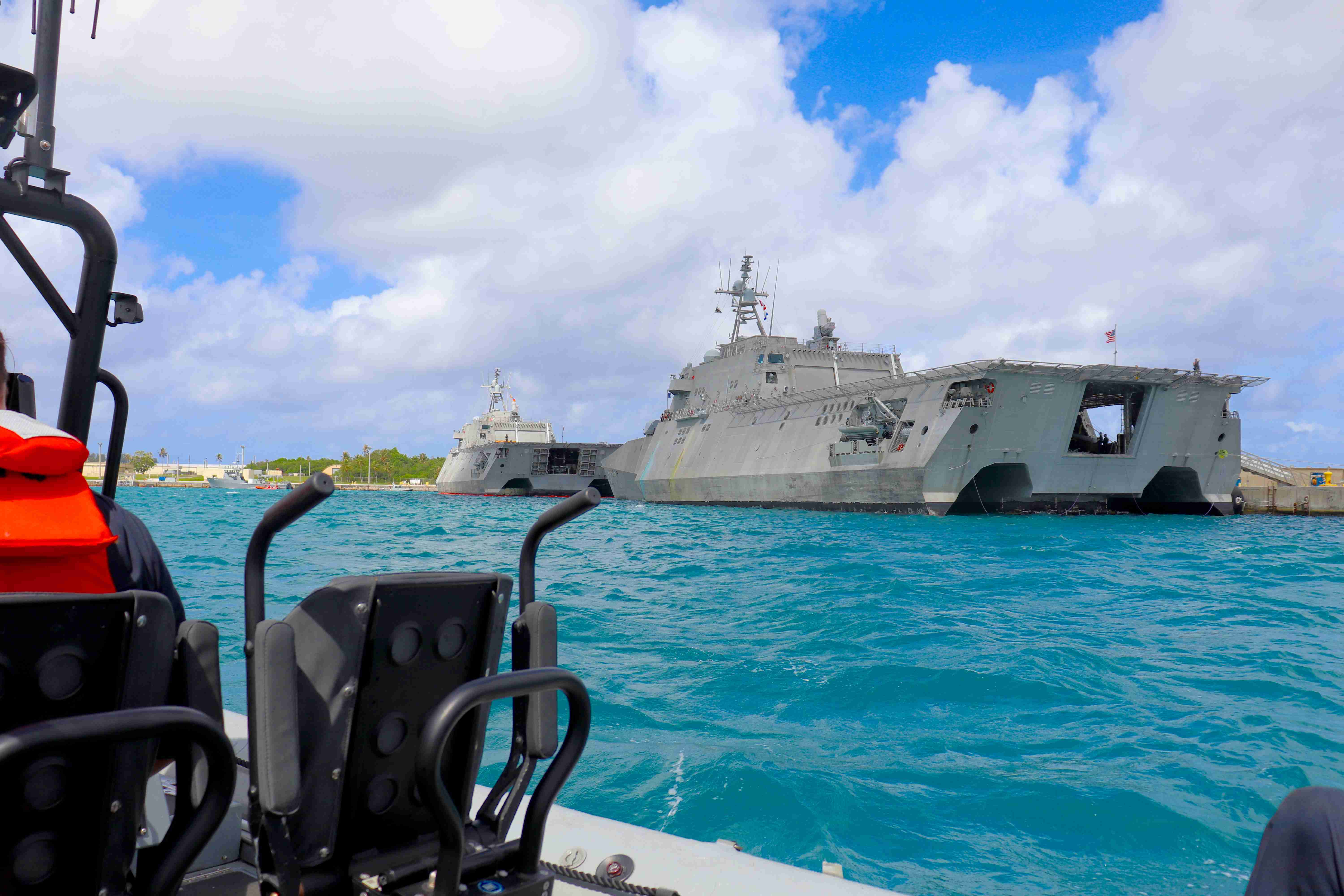
The Independence-class littoral combat ship USS Charleston (LCS-18), right, and the Independence-class littoral combat ship USS Tulsa (LCS-16) moored pierside as seen from the 11m rigid-hull inflatable boat (RIB) launched from Charleston on April 27, 2022 in Guam. U.S. Navy Photo
The next day, the ship successfully launched a Rolling Airframe Missile (SeaRAM) during an at-sea, live-fire exercise and continued heading west toward the U.S. 7th Fleet region. Charleston embarked a U.S. Coast Guard law enforcement detachment and, in May 2021, supported maritime law enforcement missions under the Oceania Maritime Security Initiative, with an eye on regional security and thwarting illegal, unregulated and unreported fishing.
For the next two years, working with Singapore-based Destroyer Squadron 7, Charleston conducted mine warfare training in the Indo-Pacific and joined in numerous training exercises with U.S. allies and partners in the region, including France, Sri Lanka, Philippines, Indonesia, Japan, Brunei, Thailand, Australia and New Zealand, according to the Navy. Exercises included Cooperation Afloat Readiness Training iterations in Brunei, Malaysia, Sri Lanka, and Timor Leste as well as Exercise Kakadu 2022 off northern Australia, Operation Noble Vanguard 22 in the Sea of Japan, Operation La Perouse in the Bay of Bengal, and Super Garuda Shield in the Natuna Sea off Indonesia.
During Noble Vanguard, an integrated mine-countermeasure training exercise held in May 2022, Charleston and its crews worked together with expeditionary seabase USS Miguel Keith (ESB-5) and mine countermeasures ship USS Chief (MCM-14). The linkage with Miguel Keith as a floating staging base enabled mine warfare and mine countermeasures units to practice expeditionary logistics and support.
And Charleston did numerous patrols in the East China Sea and South China Sea – the latter a hotbed of Chinese naval and maritime presence.
Maintenance teams support
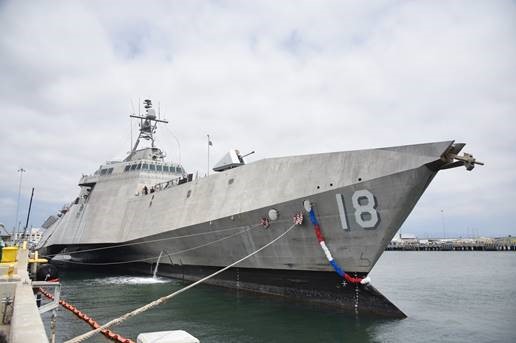
Independence-variant littoral combat ship USS Charleston (LCS 18) moors pier side at its homeport of Naval Base San Diego, June 14, 2023. US Navy Photo
Officials credit maintenance support with sustaining Charleston throughout its two-plus years of operations.
“We are moving forward on the policies of doing better sustainment of the hull while we’re forward for long durations of time, and that maintenance support was exclusively contracted,” said Capt. Douglas Meagher, commodore and commander of LCS Division 11 and Mine Warfare Division 12. “So with use of the Maintenance Expeditionary Teams, we get significant support from the sailors in the windows of opportunity that increase the sustainability of the hull during these deployments.”
The Navy, in August 2022, shifted the placement of the LCS Maintenance Execution Teams, or METs, to the Southwest Regional Maintenance Center’s Expeditionary Maintenance Department in San Diego. The LCS-1 METs are comprised of sailors experienced in the ship and its systems and can support intermediate maintenance at overseas bases and assist LCS crews with preventative maintenance.
The ship’s crew did typical preventative maintenance while underway or in port. There, “Maintenance Execution Teams, METs, will come aboard and they will perform various preventative maintenance and then, if necessary, corrective maintenance would be done through both the METs and outside and working with ship’s force,” said Knuth. “So you’ll do that in port and you’ll do a typical maintenance underway as well.”
When in port, “we’ll get a lot of this maintenance done and then go back out and perform whatever task we need,” he said. METs, he added, “kept our ships ready for tasking.”
“The operational availability of the platform, writ large, is improving, and it’s improving to a great extent to Charleston’s work on this deployment,” said Meagher, who had commanded USS Coronado (LCS-4) on its maiden Western Pacific deployment. “The operational availability is steadily improving across the class. A lot of that is tied to the strategies that we applied due to maintenance and sustainment of the platform and the use of Maintenance Execution Teams… and the general maturity of the platform in the lifecycle of LCS that is improving the operational availability to meet fleet commander tasking.”
NSM and Chinese Interaction

USS Charleston (LCS-18) navigates the South China Sea, Feb. 5, 2023. US Navy Photo
While deployed, Charleston was embarked with the Naval Strike Missile, Knuth said. NSM is a long-range, precision-strike weapon that can be launched against enemy ships, and the Navy has been equipping littoral combat ships with NSM launchers.
“We do have a typical load-out that we maintain throughout the deployment,” Knuth said of the NSM. “That said, we did not do any live fire testing of the missile.”
“We operated in the East and South China seas with the NSM aboard,” he said, when asked about interactions with Chinese naval ships or maritime militia during the ship’s presence and patrols in the South China Sea and East China Sea. “I can’t speculate on the actions of near-peer competitors.”
“For near-peer competitor, they would tail a vessel in the East and South China sea,” he added, and “whether their interest was in LCS (or) the NSM, I can’t tell you.”
“The Charleston performed its mission as required,” he added. In all three of Gold Crew’s deployments, “we were not harassed by near-peer competitors.”
Mine Warfare

An MH-60S Knighthawk assigned to the ‘Blackjacks’ of Helicopter Sea Combat Squadron (HSC) 21 departs from Independence-variant littoral combat ship USS Charleston (LCS 18) in the Strait of Malacca, Mar. 1, 2023. US Navy Photo
Along with the MH-60S, Charleston deployed with the MQ-8B Fire Scout unmanned aerial vehicle for search and surveillance missions, and at times conducted simultaneous manned and unmanned flights to support the MCM mission, Knuth said.
The ship also had “components of” the LCS mine countermeasures mission package, which included the helicopter-deployed Airborne Laser Mine Detection System (ALMDS) and Airborne Mine Neutralization System (ANMS), he said, and the EOD detachment helped in training and deploying the systems. “We utilized them as an asset aboard,” he added.
“The emphasis was showing that we have the mission package and the capability to do it and not just inside U.S. waters but to do it outside U.S. waters in conjunction with other units,” Knuth said, noting its use during exercise Noble Vanguard last year. “It was a big step.”
Source : USNINews

